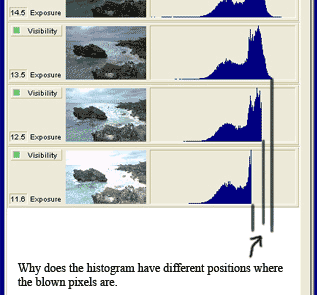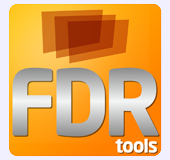Installation, Registration
Terminology
Creation of HDR images
Saving the result
Creation of Profiles
I can not open the 'key.bin' file!?
Shortly after you have ordered FDRTools a 'key.bin' file is sent to you. This key.bin file is the license key for FDRTools Advanced. You cannot "open" it. Instead do the following:
- Save the license key to a save place.
- Start the program. A registration dialog shows up.
- Within the registration dialog you can load the key.bin file to finish the registration process. Look at the bottom of the dialog. There you will find 'License key' with associated 'Browse' button. Press the 'Browse' button, navigate to the place where you have saved the key.bin file and load it.
- A message will appear confirming the successful registration.
You are done. The program will not produce watermarks any more.
What do the terms HDR image and LDR image mean?
LDR image stands for Low Dynamic Range image.
The term refers to images whose data is saved in a 'traditional' image format.
Formats like JPEG are very limited with respect to their presentable tonal value range.
With the 8 Bits of data per color channel one can distinguish only 255 different tonal values.
The presentable dynamic range, i.e. the ratio of highest to lowest possible intensity value is hence only 255 : 1.
This dynamic range is far to small for lossless saving of scenes comprising both strong light sources and deep shadows.
Such scenes can easily have dynamic ranges of 100,000 : 1 and more.
HDR image stands for High Dynamic Range image.
HDR images are stored in a format that can present a much broader range of intensity values per pixel and color channel compared to LDR image formats.
Lossless storage of HDR images generated with FDRTools requires an according HDR image format.
Examples of such HDR image formats are OpenEXR, Radiance RGBE and TIFF with 32 Bits per color channel.
Neither HDR nor LDR are exactly defined terms.
It is e.g. not clear whether a dynamic range of 1000 : 1 is an HDR or not.
What is a Tonal Range Spectrum?
An other term for Tonal Range Spectrum is Histogram.
A histogram shows for each possible intensity value the number of pixels exhibiting this intensity value.
The broadness of a tonal range spectrum is a measure for the dynamic range of the associated image.
What does Tone Mapping mean?
Tone Mapping is a general term denoting every kind of transformation of the tonal range spectrum of an image.
Gradation curves are also a kind of Tone Mapping for example.
The meaning in conjunction with HDR imaging is more specific.
Tone Mapping here means a mapping that compresses the tonal range spectrum of an image.
The goal of Tone Mapping is to scale down the dynamic range of an HDR image such that the resulting image can be presented on a traditional display medium.
Moreover the Tone Mapping process shall not degrade image quality.
This means that no artefacts shall arise and details and contrast shall be reobtained from the HDR image resp. the original images.
After all the Tone Mapping process shall result in a visual pleasing result.
In the course of the past decade a lot of differing Tone Mapping methods have arised.
A good overview of Tone Mapping methods can be found at Fredo Durand.
What is Tonal Range Compression?
Tonal Range Compression denotes the meaning of Tone Mapping in conjunction with HDR imaging.
What does Image Registration mean?
When shooting an exposure series it is difficult to impossible to keep the camera absolutely steady.
As a result the photos won't fit together perfectly.
Even when mounting the camera to a tripod one will often find slight misalignments of the source images.
These misalignemts are caused by slight camera jiggling.
When blending these images together into an HDR image the misalignments yield slightly unsharp or blurry results.
Goal of the Registration is to correct the camera movements afterwards using a computer in order to align the images perfectly.
And what is DRI?
DRI means Dynamic Range Increase and denotes a technique that tries to blend several differently exposed images manually using an image editing application.
Layers, masks and brushes are some of the tools that are necessary to do this.
Goal of the technique is to map a scene of high dynamic range to an image with low dynamic range without loosing the contrast of the original photos.
In other words: goal is a tonal range compression without loosing contrast.
DRI does not produce an HDR image as intermediate step.
DRI is a time consuming technique and the achievable results strongly depend on the image editing skills of the editor.
What is the optimal exposure increment for an exposure series?
We recommend the following increments: with JPEG images 2 EV, with RAW images 3 EV.
Basically: the fewer images an exposure series has the better.
Fewer images save storage and computing time.
Fewer images also mean less problems caused by camera jiggling and easier handling of moving objects.
The mentioned recommendations guarantee good results at any rate.
However, it is possible to choose larger exposure imcrements.
With JPEG images you can safely choose increments up to 4 EV, with RAW images up to 5 EV.
It depends on the noise behaviour of the CCD sensor what is possible.
Trying out will show you the limits of your camera.
FDRTools measures the exposure values of the source images and joins these into a single image - the HDR image.
Then the dynamic range of the HDR image is calculated as the ratio of highest to lowest intensity value, logarithmised to base 2.
This value is to be understood as an approximation.
A precise value requires good image material:
- you should use RAW images
- the darkest image should not have any overexposed pixel
- the lightest image must not have noisy pixel
When using a single RAW image the dynamic range often shows an unreal high value.
This is caused by noisy pixel.
The value of such a pixel is not determined by incoming light but by camera electronic noise.
Hence the pixel value is normally far away from the real value.
If a noisy pixel by accident takes on a very small value - sometimes even zero - then this can result in enormous dynamic range values.
According to the definition the exposure value for a short exposure time is higher than it is for a long exposure time. So for the images of a bracketed series the following is true: the darker the image the higher its exposure value.

Histograms of lighter images are shifted to the left by their EV difference to the darkest image. Ideally this should bring all the histograms to coincidence (of course the lighter images are partly outblown). This provides a visual feedback of the exposure detection process and makes the Separation blending method with its separation sliders more intuitive.
With RAW images this works very good as their data is linear (or nearly linear) by nature - the histograms have an identical shape. With JPEGs you will encounter different results, i.e. the histograms will not line up as nicely. The reason is that JPEG data is not linear.
Normally HDR images have a high dynamic range, that is the ratio of highest intensity value to lowest intensity value.
Real scenes easily reach ratios of 100000 : 1.
But a common monitor is capable of displaying ratios of only 100 : 1 to 400 : 1 (TFT) in a "natural way".
Hence images with higher dynamic range look dark when displayed on such a device.
Therefore an untreated HDR image is not usable for e.g. presentation in the web.
That's the reason why these images need to be tone mapped - which is essentially the same as compressing the dynamic range of the image so that it "fits" the monitor - to get a presentable image.
Using the slider beneath the HDR image you can change the currently visible part of the intensity spectrum - or expressed in other words "change the exposure".
This way you can inspect the darker parts of the HDR image too.
Why do I sometimes get pink highlights with Raw images and the Don't clip colors option active?
With Raw images by default only those pixels are used that have valid values in all color channels.
"Overexposed" pixels are not used.
However, often these "overexposed" pixels contain usable information.
The reason is that the color channels do not behave alike with respect to exposure.
They generally saturate at different quantities of light.
Especially the red channel seems to tolerate considerably more light without saturating.
Thus if green and blue channel are saturated the red channel may still give good values.
This only happens in the highlights causing them to look pink.
The pink highlights are not a problem though.
You can easily get them white with an appropriate white point setting.
Why does the Preview sometimes show a regular pixel pattern?
This pixel pattern becomes visible in LDR Mapping mode Compressor.
It is not caused by a software bug.
Rather - caused by the compression algorithm - the result of tone mapping depends on resolution and the visible field of view.
Hence Navigator and Preview yield different results.
The pixel pattern shows Navigator pixels within the Preview.
This way the pattern reveals intensity differences between Navigator and Preview.
The resulting HDR image suffers from red/blue/green color casts. What happened?
Probably you took the images with automatic white balance.
Always use identical white balance setting for all images of an exposure series!
I stitch panoramas from single images. When to create the HDR image - before or after stitching?
Either use is possible. I personally create the HDR prior to stitching. HDR images have a wider tonal range.
This makes adjustment of color or brightness differences in the overlap regions easy!
Is the RAW format of my camera supported by FDRTools?
Probably yes. FDRTools utilizes dcraw as Raw converter so most camera formats are supported. Exceptions are the Sigma cameras (the decoding algorithm for Foveon chips within dcraw is GPL licensed so we can't use it).
New cameras may not be supported immediately because the dcraw version integrated with FDRTools is updated with the FDRTools release cycle and hence is normally behind the latest dcraw version.
Can I save the tone mapped result in JPEG format?
Yes. However, saving the tone mapped image in JPEG format is not advisable. Here is why: FDRTools is not (and does not want to be) a full fledged image editing application. Things like retouching, sharpening, resizing etc. are not implemented in FDRTools. Therefore, the resulting image should be saved in a lossless format like TIFF. so that you have best possible quality available in your favourite image editing application.
Why is the Eposure Interval limited to a maximum of 1 EV?
In order to determine the TRC exactly it makes sense to have enough measuring values at hand.
Exposure Intervals of 1 EV or less are therefore favourable.
1 EV seems to be best suited as cameras seem to keep this interval very precise.
1/2 or 1/3 EV does not seem to function that exact.
|

